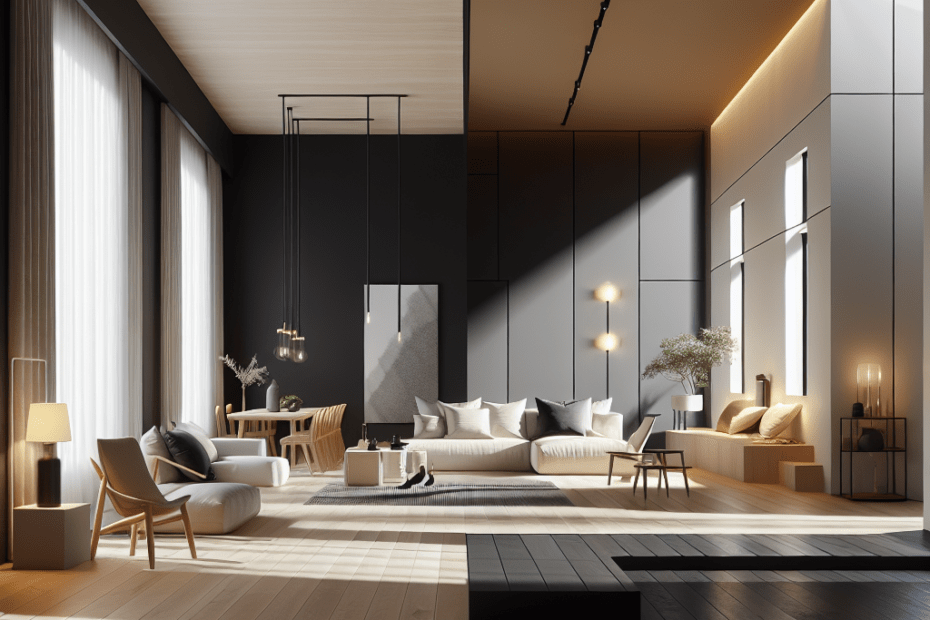“`html
Creating Visual Contrast with Light and Dark Walls
When new homeowners or interior design enthusiasts strive to create a visually stunning environment, they often encounter the concept of light and dark wall design. Experts agree that knowing how to effectively combine light and dark elements in a room can greatly enhance its aesthetic appeal.
Balancing these contrasting tones is not just an art, it’s a scientifically-backed design strategy that can impact the perception of space, mood, and functionality. According to a 2021 survey by the American Society of Interior Designers, 75% of participants indicated a preference for rooms with clear contrast in tones for visual interest (ASID). But how exactly can they achieve that look effectively?
The Importance of Light and Dark Wall Design
Light and dark wall design isn’t just about painting the walls; it’s about crafting a mood and experience. Light walls can open up a room, making it feel larger and airier, while dark walls can add depth, sophistication, and a cozy feel. Correctly balancing these can create a harmonious environment.
Choosing the Right Colors
Before painting, it’s crucial to select colors that will work together. They recommend using a color wheel to find complementary colors. When choosing a dark color, they look for deep shades like navy blue, charcoal, or forest green, which work well with light tones like soft creams or muted pastels.
Strategic Application
Strategically applying light and dark colors can have transformative effects. Designers often experiment with accent walls, painting one wall darker to create a focal point in the room, while keeping the surrounding walls light to maintain spaciousness.
Lighting Effects
Lighting plays a significant role in how colors appear. In spaces with ample natural light, darker walls can be more prominent while still feeling balanced. However, in rooms with limited lighting, using lighter shades can keep the space bright. It’s important to consider the natural and artificial lighting in the room before painting.
Materials and Textures
A sophisticated light and dark wall design goes beyond paint. Using different materials like wood panels, brick, or wallpaper can add texture and interest. For instance, a dark brick wall paired with light painted walls can create a rustic yet modern vibe.
Psychological Effects
Colors significantly impact mood and emotions. Light colors on walls can invoke a sense of calm and relaxation, ideal for bedrooms and bathrooms. In contrast, darker colors can add drama or a feeling of intimacy in spaces like dining rooms or libraries.
Combining Patterns
Patterns can create additional layers of depth in a room with light and dark walls. They suggest using patterns like stripes or geometric designs that blend both light and dark hues. These patterns can be incorporated through wallpaper, fabrics, or even painted designs.
Practical Maintenance Tips
Like every design choice, this one also has maintenance considerations. Dark walls may show dust or fingerprints more prominently, while light walls might need more regular cleaning to prevent discoloration. Choosing the right type of paint can help, such as a washable matt finish for darker colors.
| Aspect | Light Walls | Dark Walls |
|---|---|---|
| Perception | Spacious, Airy | Cozy, Sophisticated |
| Lighting Needs | Less Dependent | More Natural Light Needed |
| Maintenance | More Frequent Cleaning | Careful with Dust/Fingerprints |
Key Takeaways
- Select colors using a color wheel ensuring they are complementary.
- Use accent walls to introduce dark tones without overwhelming the space.
- Leverage lighting to accentuate wall colors effectively.
- Introduce textures and patterns for added depth.
- Consider the psychological effects of color when planning spaces.
FAQ
- What should I consider when choosing wall colors?
Consider the room’s natural light, its purpose, and how different colors can evoke emotions.
- Can I use more than two colors?
Yes, but ensure they complement each other to avoid overwhelming the space.
- What are some popular dark wall colors?
Popular choices include navy blue, charcoal, and forest green.
- How do light and dark colors affect room size perception?
Light colors make a room feel larger and more open, whereas dark colors can create a cozier, more intimate space.
- What type of lighting enhances a dark wall?
Natural light and strategically placed artificial lighting such as wall sconces or floor lamps can enhance dark walls.
“`
